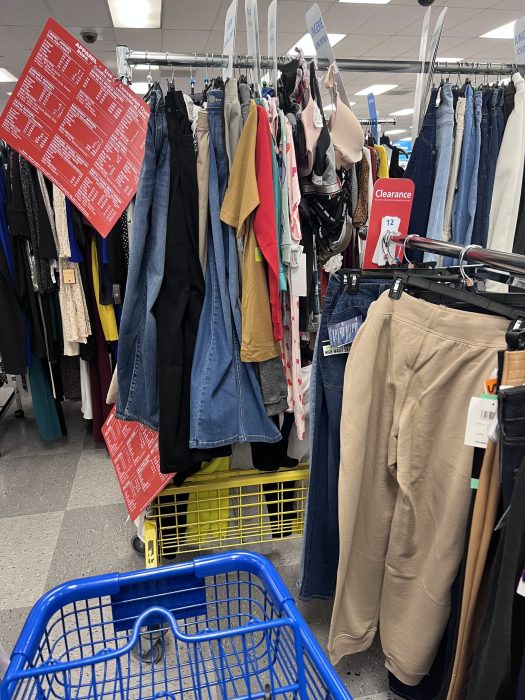My fashion wants are clashing against the lure of fast clothing and my need to be a good environmental steward
A SENIOR BEAT COLUMN
Several recent online purchases of clothing that turned out to be flubs got me to soul searching. Maybe if they had been winners, I wouldn’t but they weren’t.

As a woman who enjoys fashion, I want new clothes, but thought: Do I need them?
I remember becoming aware of the difference between wanting and needing one day when I was in Walgreen’s. I observed a kid, maybe three or so, screaming at his mother, “I need that (fill in the blank) toy!” OMG, I said to myself, have advertisers accomplished their goal of obsession indoctrination in children?
The American obsession with buying things we may not need was brought into focus after 9/11 when President Bush said the best way to heal our wounds was “to go shopping.”

Talk about shopping, a friend who owned a clothing store in San Anselmo said she only wanted customers who had the “disease.” What was that I asked. “Someone who will buy not only the skirt and blouse, but the belt, the scarf, the earrings and the necklace…and a jacket to go with.”
I don’t have a full-blown disease, but I’m certain I have a more than mild case. I am ashamed to fess up that I only wear one-quarter of my clothes. The rest hang like discarded ragdolls or lay like sleeping Snow Whites, waiting for a prince that never arrives.
When my cousin peeked in my closet at my jacket collection, she said it looked like a rack at Macy’s. But, I countered, I need all those different jackets for San Francisco’s many micro-climates! That rational has a ring of truth to it, but it’s only a tiny bell compared to the bigger truth that I love jackets and crave a variety.
Focused on jackets
In my 60s, I started wearing only pants, no more skirts or dresses. I lost my waist, wasn’t ever going to find it again, and pants with elastic waists were the comfortable choice. So, aside from buying shirts or sweaters – kind of boring – my fashion focus became jackets.
In the past few years, I have been trying to add a Japanese flair to my look – baggy pants, big shirts and oversize jackets. I found a very smart green, oversize cotton jacket at Zara’s a couple of years ago, and even though I still love it, it just whetted my appetite for more jackets in the Japanese style.
But I had to whipsaw my attention back to pants when the cold weather set in this year. I only had one pair of warm black joggers decent enough to wear out, so I took the Internet train over to Etsy.com for a looky-loo.
Etsy.com is a huge online shopping mall of independent retailers. Reviews help you decide who to fork your money over to, but it’s easy to get sidetracked in the funhouse of choices.
Day Glo, oh no!
My first online purchase was a pair of rust-colored joggers. But when they arrived, I was horrified to see that they were Day-Glo orange. And the material was sleazy. What was the material, anyway? In my buzz of excited shopping anticipation, I failed to look at what the heck they were made of.

The label revealed that my pants were 78 percent polyester, the rest a combination of rayon and spandex. What exactly is polyester? It’s Polyether-polyurea copolymer, a form of plastic, a petroleum product.
As Dustin Hoffman’s character said in the movie “The Graduate” 50 years ago, “The Future is ‘Plastics’.” Was he ever prescient.
It’s almost impossible to find clothing today that isn’t made of plastic – that is, the “fast” clothing that pervades the clothing industry – made cheaply to entice ever more purchases. The joggers I bought were $22. After my flub, I searched the Internet and found all-cotton joggers for $88. (Be forewarned: many retailers will claim all cotton but sneak in the plastic.)
Every wash = waste
We know that plastic bags and containers that end up in landfill are bad for the environment, but with fast clothing (largely synthetic plastic), the destruction begins much sooner. Each time we wash them, they shed millions of plastic microfibers, according to a Vox Media report. There are no filters in washing machines or wastewater plants that can capture these tiny fibers, so they wind up in the ocean.
In the ocean, they absorb nasty chemicals. Sea creatures eat them and pass the plastic microfibers up the food chain toward human consumption. Some studies have found them in foods like mussels.
But it’s hard not to buy plastic clothes because we have become used to the stretch and breathability of synthetic materials in athletic and leisure wear and in lightweight, cold weather clothing. I’m old enough to remember lumbering around in those heavy wool coats we wore in biting East Coast winters.
I want to do my bit to save our planet, so I have a plan. If I can’t find any reliably 100 percent cotton joggers for less than $88, I will buy those – but make do with a couple of pairs instead of a fast four at $22. I will wear tights under my looser cotton pants. I will survive the winter without shedding more plastic into the ocean.






Jennie
If there is an organization or business that accepts natural fiber clothes/other textiles for purposes of recycling the fiber, I would love to know about them. Some clothing/textiles are not worth donating to a Goodwill, Salvation Army, etc. I've been accumulating items during the pandemic, but don't know what to do with them.
Dina Lisha
Very informative and well written 👏. I will now change my shopping habits. Thank you 😊
Terri Wong
I both restore and wear antique clothing. Many of my favorite garments date to late 1800s and early 1900s. My standing rule is that if one "new" garment comes in, at least one has to leave my closets. I recycle my clothing at local vintage shops in San Francisco or gift them to my friends.